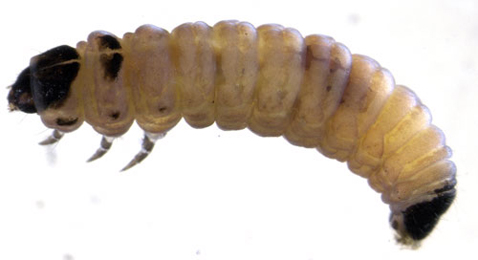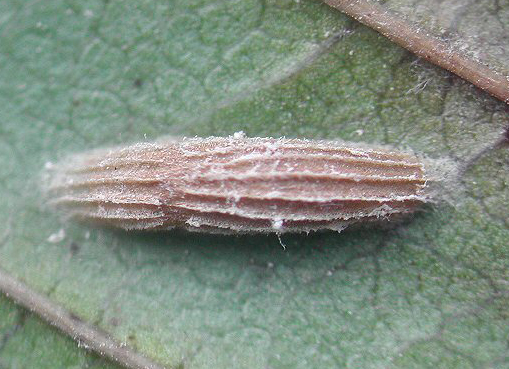|
||||||
|
RHAMNUS. Buckthorns. [Rhamnaceae] |
|
Three species of Rhamnus are recorded in Britain. These include the native Buckthorn (R. catharticus). Five British miners are recorded on Rhamnus. A key to the European miners recorded on Rhamnus s provided in Bladmineerders van Europa. |
|
Key for the identification of the known mines of British |
1a > Leaf-miner and case-bearer: The larva lives outside the mine, protected by a case, and feeds on the underlying plant tissues via a hole cut in the epidermis. From that point it eats away as much leaf tissue as it can reach without fully entering the mine. Mine does not contain frass (Coleophora species) |
1b > Leaf-miner, but not a case-bearer: The larva lives mainly inside the mine. Mine usually contains frass. In later instars the larva may live sandwiched between two more or less circular sections cut from the leaf. |
2a > Leaf-miner and case-bearer: Lobe case. The full grown case is about 7 mm long. The mouth angle is 0°, causing the case to lie flat on the leaf. The case is gradually enlarged by the addition of rings that are cut out of the epidermis. The rings become gradually larger, and stick irregularly out of the contour of the case. The rings are cut out of the lower epidermis of the mine. This implies that mines may have both normal, small openings, and large ones. Compare for instance C. violacea, that cuts rings out of the upper epidermis (Bladmineerders van Europa). The larva feeds briefly initially and again after over wintering. It then aestivates until Autumn. It makes one case which it enlarges by adding pieces of excised lower epidermis (British leafminers). |
|
Coleophora ahenella Heinemann, 1877 [Lepidoptera: Coleophoridae]. |
2b > Leaf-miner and case-bearer: The larva feeds on a wide range of trees, shrubs and herbs, favouring Rosaceae, but not exclusively. The fully developed cased larva may be found active in October and again, after winter diapause, in April. Cases, about 6 mm, of diapausing larvae may be found through winter, fixed to a tree or fence post. The dorsal surface of the case is usually covered in leaf fragments, but they can sometimes be worn off almost smooth. The ventral surface is swollen at the middle and has a keel, which usually bends upwards at the posterior. The cases of C. ahenella (on Rhamnus, Frangula, Viburnum and Cornus) and C. potentillae (case less swollen, keel not bent up, resting position less prone) are very similar (UKMoths). Brownish lobe case that lies almost flat on the leaf, either on the upper or on the lower side. Case widest about the middle. Ventrally there is a distinct keel. Mouth angle 0°. Full depth mines rather large. The flaps of cuticular tissue that serve to enlarge the case are cut out of the upper epidermis. (contrary to C. ahenella and C. potentillae, that use tissue from the lower epidermis). The removal of these tissue flaps creates holes that are much larger than those that serve as the entrance to the mine (Bladmineerders van Europa). |
 Coleophora violacea larva, lateral Image: © Willem Ellis (Bladmineerders van Europa) |
|
Coleophora violaceae (Ström 1783) [Lepidoptera: Coleophoridae]. |
3a > Leaf-miner: The highly distinctive, violet or purplish spiral mines of this species are often the key to its discovery. They can be found on leaves, often several to a leaf. After the initial leaf-mining phase, the larva feeds externally on the underside of the leaves, creating small feeding windows, before pupating in a ribbed cocoon typical of the Bucculatriginae (UKMoths). A narrow corridor, densely wound, amost entirely filled with purplish brown frass. The last 1 to 2 cm of the corridor are free from the spiral, and almost straight. At this point the mine is left and the larvae continue to live free on the leaf, causing window feeding. The empty larval chamber, obviously free from frass, is conspicuousy slender. The egg, in the very centre of the spiral, is at the leaf lower side, as is the exit from the mine (Bladmineerders van Europa). |
 Bucculatrix frangutella cocoon Image: Rob Edmunds (British Leafminers) |
|
Bucculatrix frangutella (Goeze, 1783) [Lepidoptera: Bucculatricidae]. |
3b > Leaf-miner: A long, whitish smoothly-curved upper-surface mine with broken black frass (British leafminers). Oviposition is by means of an ovipositor; what remains is a small scar: no egg shell is visible at the start of the mine. From here a long, sometimes very long, slender, full depth corridor winds throught the leaf, not steered by leaf margin or the leaf venation. The midrib is crossed effortless; the corridor frequently also crosses itself; the section of the leaf cut off then usally turns brown and dies off. Frass in a narrow central line. The larva vacates the mine prior to pupation through an exit in the upper epidermis. The vacated larval chamber is proportionally much longer than in the case of Stigmella mines ( > 3 x longer than broad) (Bladmineerders van Europa). Pupation in a silken cocoon suspended from threads attached to food plant or other vegetation (British leafminers). |
|
Lyonetia clerkella (Linnaeus, 1758) [Lepidoptera: Lyonetiidae]. |
3c > Leaf-miner: The gallery is contorted in a series of S turns. The frass is initailly cloudy but then darker green being either dispersed or coiled (as shown). A little area of uneaten leaf is between each traverse. Finally the frass turns black and is deposited in a central line. The larva is greenish yellow, head pale brown (British leafminers). Full depth corridor, beginning at an under-surface egg shell. The corridor makes several sharp turns, causing the loops to (mostly) almost touch each other. In the last section the corridor is appreciably wider. Frass olive green when fresh, brown later, coiled for most of the length of the corridor. Pupation outside the mine (Bladmineerders van Europa). |
|
Stigmella catharticella (Stainton, 1853) [Lepidoptera: Nepticulidae]. |
| Last updated 26-Jan-2018 Brian Pitkin | ||
